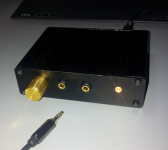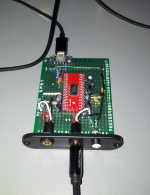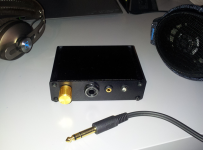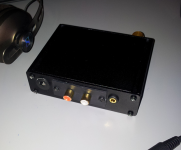Some might remember I mentioned I was having a go at building one in another thread where I built a couple of basic ones - tonight finally got the result I was looking for 
Quite a steep learning curve as I've not really touched electronics in any real way since dropping out of electrical engineering 15 odd years ago and I'd chosen the AD8066 op amp early on which being a high speed IC can't just be dropped into any old circuit with good results.
Not much to look at but image of the debug board - finally ready to commit the design to the final PCB (with some layout adjustment) and box it up (will upload pics of the enclosure when its all done):
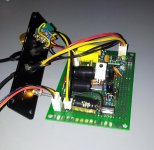
(Some of the components at funny angles due to height restrictions on the enclosure I have in mind).
At its heart its basically a cmoy with some minor tweaking (mostly in regard to bypass capacitors) with goldpoint's experimental fully regulated virtual ground which seems to be the best power supply option with the 8066 - fully stable from 16 ohm through to 300 in my testing with plenty of power for the higher ohm headphones and no problems supplying the voltage for lower (no hint of clipping). AC/DC noise has been effectively eliminated when using wall power (its intended for desktop use) and there is virtually no background noise even with sensitive headphones - not even a hint of hiss until you really wind it up.
While ideally an op amp should be sonically transparent the 8066 does some magic with the bass that had to be heard - bass is really deep, extended and crisp and overall really happy with the sound - through the whole frequency range its pin sharp and punchy with good separation - playing something like Hotel California for testing the instruments have a satisfyingly lifelike quality. Only criticism is that the upper mid-range is a little bit what I believe is referred to as "veiled" and could be a little livelier.

Quite a steep learning curve as I've not really touched electronics in any real way since dropping out of electrical engineering 15 odd years ago and I'd chosen the AD8066 op amp early on which being a high speed IC can't just be dropped into any old circuit with good results.
Not much to look at but image of the debug board - finally ready to commit the design to the final PCB (with some layout adjustment) and box it up (will upload pics of the enclosure when its all done):

(Some of the components at funny angles due to height restrictions on the enclosure I have in mind).
At its heart its basically a cmoy with some minor tweaking (mostly in regard to bypass capacitors) with goldpoint's experimental fully regulated virtual ground which seems to be the best power supply option with the 8066 - fully stable from 16 ohm through to 300 in my testing with plenty of power for the higher ohm headphones and no problems supplying the voltage for lower (no hint of clipping). AC/DC noise has been effectively eliminated when using wall power (its intended for desktop use) and there is virtually no background noise even with sensitive headphones - not even a hint of hiss until you really wind it up.
While ideally an op amp should be sonically transparent the 8066 does some magic with the bass that had to be heard - bass is really deep, extended and crisp and overall really happy with the sound - through the whole frequency range its pin sharp and punchy with good separation - playing something like Hotel California for testing the instruments have a satisfyingly lifelike quality. Only criticism is that the upper mid-range is a little bit what I believe is referred to as "veiled" and could be a little livelier.


 if I can find a programmers adapter thats not like £90 for them I might just go with that as I don't seem to have much joy soldering them by hand hehe...
if I can find a programmers adapter thats not like £90 for them I might just go with that as I don't seem to have much joy soldering them by hand hehe...
